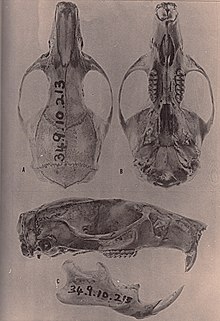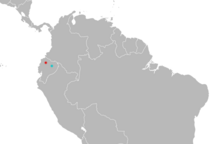Mindomys hammondi
| Mindomys hammondi | |
|---|---|
 |
|
| Skull and mandible. | |
| Scientific classification | |
| Kingdom: | Animalia |
| Phylum: | Chordata |
| Class: | Mammalia |
| Order: | Rodentia |
| Family: | Cricetidae |
| Subfamily: | Sigmodontinae |
| Tribe: | Oryzomyini |
| Genus: |
Mindomys Weksler, Percequillo, and Voss, 2006 |
| Species: | M. hammondi |
| Binomial name | |
|
Mindomys hammondi (Thomas, 1913) |
|
 |
|
| Distribution of Mindomys: Mindo (type locality) in red; Concepción (dubious second locality) in blue. | |
| Synonyms | |
|
|
Mindomys hammondi, also known as Hammond's rice rat or Hammond's oryzomys, is a species of rodent in the tribe Oryzomyini of family Cricetidae. Formerly considered to be related with Nectomys, Sigmodontomys, Megalomys, or Oryzomys, it is now placed in its own genus, Mindomys, but its relationships remain obscure; some evidence supports a placement near Oecomys or as a basal member of Oryzomyini.
Mindomys hammondi is known only from Ecuador, where it occurs in montane forest; a record from the Amazon basin lowlands is dubious. Reportedly, it lives on the ground and is associated with water; other suggest it lives in trees. A large, long-tailed, and long-whiskered rat, its fur is buff above and abruptly lighter below. The front part of the skull (rostrum) is heavily built.
The species is named after the collector who first found it, Gilbert Hammond. He supplied natural history specimens to Oldfield Thomas and others.
In 1913, Oldfield Thomas of the British Museum of Natural History (BMNH) in London published the first description of Mindomys hammondi, using two specimens collected at Mindo in Pichincha Province, Ecuador, in 1913 by Gilbert Hammond. He named the species Nectomys hammondi, classifying it in the genus Nectomys, which at the time included not only the large water rats currently placed in it, but also Sigmodontomys alfari and Oryzomys dimidiatus. He considered the animal to be most closely related to Nectomys russulus, a species he had himself described in 1897 and which is now recognized as a synonym of Sigmodontomys alfari.
...
Wikipedia

